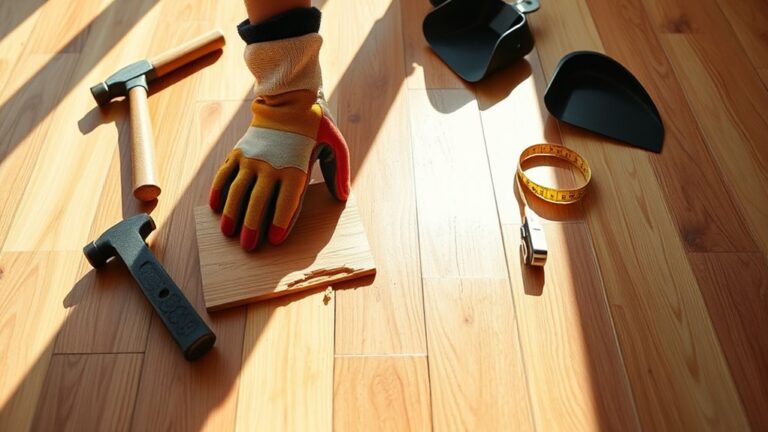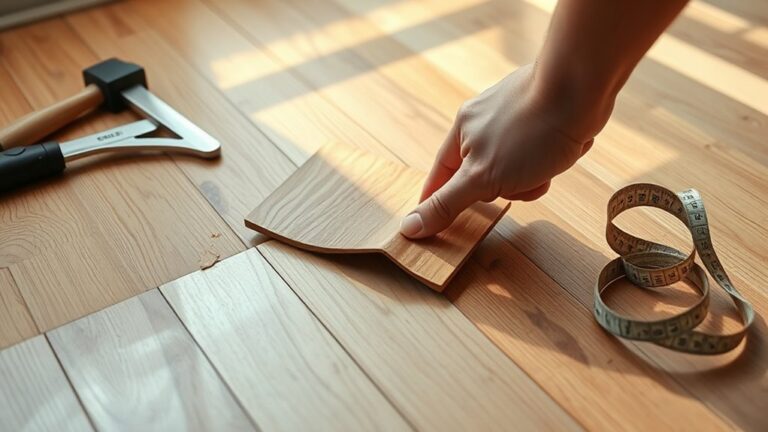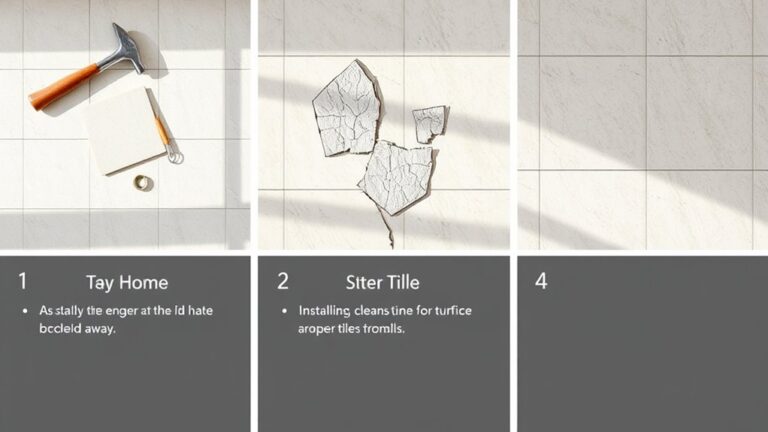If you're fixing curling vinyl floor edges, start by identifying moisture issues, as they're often the root cause. Clean the area under the curled edges with a vacuum and a putty knife. Use a heat gun or hair dryer to soften the vinyl, then apply quality adhesive beneath it. Secure the edges with heavy objects for at least 24 hours to guarantee proper bonding. Consider installing shoe molding to enhance both aesthetics and security. Regular maintenance and immediate attention to leaks will help prevent future curling. There's more to explore about effective strategies for long-lasting repairs and prevention techniques.
Understanding Vinyl Curling Issues
Vinyl curling issues can be a frustrating problem for homeowners, especially when they appear at the edges of your flooring. This common issue typically occurs near walls and wet areas, where moisture can infiltrate past caulk seams or lead to adhesive failure. You might notice the vinyl curling anywhere from 1/4 to 3/8 inches, often exacerbated by water dripping from fixtures like tubs or showers. Such moisture can loosen the adhesive, causing the edges to lift.
To tackle these curling problems, it's essential to first address any underlying moisture issues. Check for leaks and verify that the subfloor is dry before attempting to re-adhere the vinyl flooring. Once you've resolved moisture concerns, you can apply heat to the curled edges using a hair dryer or heat gun. This technique softens the vinyl, allowing for better adhesion when you apply new adhesive.
Additionally, consider installing shoe molding or quarter round around the perimeter of your vinyl flooring. This can effectively secure the edges and help prevent future curling by reducing stress on the adhesive. By understanding the root causes of vinyl curling issues and taking proactive measures, you can maintain the integrity and appearance of your flooring, preserving the freedom to enjoy your home without the worry of ongoing repairs.
Essential Tools for Repairs
To effectively repair curling vinyl floor edges, you'll need several essential tools at your disposal. Start with a vacuum cleaner for debris removal, and keep a putty knife handy for scraping old adhesive. Don't forget a heat gun or hair dryer to soften the vinyl and contact cement to guarantee a strong bond during the repair process.
Recommended Repair Tools
Successful repairs to curling vinyl floor edges require the right tools to secure a clean, effective process. Start with a vacuum cleaner to remove any dirt and debris lurking under the curled vinyl. This step is essential for guaranteeing proper adhesion when you apply your flooring adhesive later.
Next, a putty knife will be your best friend for scraping away old adhesive from the subfloor. A clean surface is significant for a successful bond. Once the area is prepped, you can use a heat gun or hair dryer to warm the vinyl, making it more pliable and easier to manipulate during repairs.
When it comes to re-adhering the vinyl, opt for a robust flooring adhesive like contact cement. This will help secure that the vinyl stays in place long-term. Finally, while the adhesive cures, weigh down the vinyl edge with heavy objects, such as books. This will ensure a strong bond and prevent future curling.
Safety Gear Essentials
When tackling repairs on curling vinyl floor edges, it's just as important to prioritize your safety as it is to have the right tools on hand. Here's a quick rundown of essential safety gear you should consider:
| Gear | Purpose |
|---|---|
| Safety Goggles | Protects your eyes from debris and adhesive splashes |
| Safety Gloves | Shields your hands from sharp tools and irritants in adhesives |
| Dust Mask | Prevents inhalation of fine particles and fumes |
| Knee Pads | Provides comfort and protection for your knees |
| Proper Footwear | Guarantees stability and helps prevent slips or falls |
Using safety goggles is vital during the repair process to avoid any potential eye injuries. Safety gloves keep your hands safe from sharp edges and harmful substances. A dust mask is necessary to shield you from harmful particles released by adhesives. Knee pads will make your work more comfortable when kneeling on hard floors, and sturdy, non-slip footwear is critical for maintaining balance while you repair. Prioritizing safety gear not only keeps you protected but also guarantees a smoother repair process.
Repair Techniques for Curling Edges
Curling vinyl floor edges can be a frustrating issue, but with the right repair techniques, you can restore their appearance and functionality. To start fixing curling vinyl, first, clean the area beneath the curled edges. Use a vacuum cleaner and a putty knife to remove any debris or old adhesive. This step is essential for guaranteeing a good bond when you reattach the vinyl.
Next, employ a heat gun or hair dryer on a low setting to gently soften the vinyl. This process makes it easier to manipulate the curled edge back into place. Once the vinyl is warm, apply a quality flooring adhesive underneath the curled area. Press down firmly to guarantee good contact and remove any excess adhesive that seeps out.
To secure the edge while the adhesive cures, weigh it down with heavy objects, like books. Keep this in place for at least 24 hours to allow the adhesive to set properly. This is important for achieving a durable repair that can withstand foot traffic.
For a more permanent fix, you might consider installing shoe molding around the room's perimeter. This not only helps secure the vinyl edges but also adds an aesthetically pleasing finish while preventing future curling. By following these repair techniques, you can effectively address curling vinyl floor edges, enhancing your space's overall functionality and appearance.
Long-term Solutions to Prevent Curling
To prevent curling of your vinyl flooring, consider installing shoe molding around the perimeter of the room, which not only secures the edges but also improves aesthetics. Regular maintenance practices, including inspecting seams and addressing moisture issues, are essential to sustaining the flooring's integrity. Additionally, implementing moisture control strategies, such as using caulk in vulnerable areas, will help maintain the effectiveness of the adhesive over time.
Install Shoe Molding
Shoe molding serves as an effective solution for securing the edges of vinyl flooring, considerably reducing the risk of curling due to stress and moisture. By installing shoe molding around the perimeter of your room, you provide a structural barrier that protects against moisture infiltration, which can exacerbate curling issues.
Before installation, it's recommended to paint or stain the shoe molding to achieve a polished look that complements your flooring and surrounding décor. When planning the layout, visually mark start and stop points for the molding, taking care to take into account interruptions like doorways and cabinets to guarantee a seamless appearance.
Attention to detail is essential during installation. Be sure to caulk between the shoe molding and adjacent surfaces to create a tight seal. This helps maintain the integrity of the flooring and further minimizes the chances of curling. With the right approach, shoe molding not only enhances the aesthetic appeal of your space but also serves as a proactive measure against future flooring problems. By incorporating shoe molding, you're investing in the longevity of your vinyl flooring while enjoying a finished, professional look.
Regular Maintenance Practices
Maintaining vinyl flooring requires consistent attention to detail, particularly in preventing curling. By regularly inspecting seams and edges, you can catch early signs of curling and make timely repairs. Keeping your vinyl floors clean and dry is vital—address spills and leaks immediately to maintain adhesive effectiveness.
Using caulk around bathtubs and sinks creates a moisture barrier, reducing the risk of water infiltration that leads to curling. Proper installation techniques—adequate adhesive, correct temperature, and humidity levels—are important in minimizing future problems.
Additionally, consider the environment in bathrooms. Using exhaust fans can help control humidity, protecting your vinyl floors. Below is a summary of key maintenance practices:
| Practice | Frequency | Purpose |
|---|---|---|
| Inspect seams and edges | Monthly | Identify early curling signs |
| Clean spills and leaks | As they occur | Maintain adhesive effectiveness |
| Apply caulk | Annually or as needed | Create moisture barriers |
| Monitor installation climate | During installation | guarantee proper adhesion |
| Use exhaust fans | Always in use | Reduce bathroom humidity |
Moisture Control Strategies
Moisture control is essential for preserving the integrity of vinyl flooring and preventing curling over time. To safeguard your floors, regularly inspect areas prone to moisture, like around bathtubs and sinks. Identify and repair any leaks immediately, as these can lead to significant moisture buildup that contributes to curling.
Proper caulking between the tub or shower enclosure and the flooring is vital. This prevents moisture from seeping underneath the vinyl, which can compromise its structure. When installing new vinyl flooring, always use moisture-resistant underlayment. This adds an additional barrier against moisture infiltration, ensuring long-lasting performance.
Maintaining a consistent indoor humidity level is another key strategy. Aim for a range of 30-50% to minimize moisture buildup. In high-humidity areas, such as bathrooms, installing a dehumidifier can help control moisture levels effectively. This not only protects your flooring but also promotes a healthier indoor environment.
Maintenance Tips for Vinyl Flooring
Keeping your vinyl flooring in top shape requires consistent attention to detail. Regular inspections of the seams and edges are essential for identifying early signs of curling or loosening, especially in areas where moisture may accumulate. If you notice any issues, address them promptly to prevent further damage.
To minimize moisture-related problems, keep your flooring dry. Tackle leaks from showers or tubs immediately; even small amounts of water can lead to significant damage over time. When cleaning your vinyl plank flooring, make it a habit to do so regularly. Dirt and debris can weaken adhesive bonds, so use a gentle cleaner and a soft mop to maintain its appearance and integrity.
Proper installation techniques play an important role in the longevity of your vinyl flooring. Confirm that caulk is applied in vulnerable areas, creating moisture barriers that protect your investment. This step can make a noticeable difference in preventing curling and other issues down the line.
Consider applying a protective sealant periodically to enhance the durability of your vinyl flooring. A sealant can create an additional layer of defense against wear and tear, guaranteeing your floors remain looking great for years to come.
Common Causes of Vinyl Curling
Vinyl curling can occur due to a variety of factors that compromise its integrity. One common cause is adhesive failure. When the glue loses its bond, often due to environmental factors or moisture infiltration, you'll see the edges of your vinyl flooring lift. Moisture accumulation is another significant contributor. Leaks from bathtubs or showers can lead to water seeping underneath the vinyl, causing it to curl.
Poor installation practices can also play a role. If the surface isn't adequately prepared or the adhesive isn't applied correctly, the vinyl may not adhere properly, leading to curling over time. Additionally, fluctuations in temperature and humidity can cause the vinyl to expand and contract. This constant movement can weaken the seams and edges, resulting in visible curling.
Another often-overlooked factor is the accumulation of dust and debris beneath the vinyl. When these particles interfere with proper adhesion, they can create pockets of air, causing sections of the vinyl to lift and curl.
Understanding these common causes can help you take preventive measures. If you notice signs of curling, identifying the source is essential for effective repairs. Whether it's addressing moisture issues, ensuring proper installation, or maintaining a clean environment, being proactive can save you from more extensive repairs down the line. By recognizing these factors, you can better protect your vinyl flooring from curling and maintain its appearance and functionality.
Community Insights and Recommendations
Addressing curling vinyl floor edges effectively involves gathering insights and recommendations from the community. Many members emphasize that moisture issues, particularly leaks from showers or tubs, are a primary cause of this problem. Before attempting repairs, it's essential to inspect the condition of your subfloor and clean any debris. This guarantees your new adhesive will bond effectively.
When you're ready to fix the edges, some users recommend using heat application methods, like a hairdryer or heat gun, to soften the vinyl. This makes it easier for you to peel the vinyl back and reapply adhesive. After re-gluing, placing heavy objects on the vinyl can help secure a strong bond while the adhesive sets.
For a long-term solution, consider installing shoe molding or quarter round trim to secure your vinyl edges and prevent future curling. This not only enhances aesthetics but also protects against moisture infiltration that can exacerbate curling.
If you're encountering persistent issues, don't hesitate to reach out to the community for additional tips or to share your experiences. Learning from others helps you find effective methods tailored to your specific situation. Remember, keeping moisture at bay and guaranteeing a solid installation are key to maintaining the integrity of your vinyl flooring. By applying these community-driven insights, you can enjoy a more resilient and aesthetically pleasing floor.
Frequently Asked Questions
How to Fix Vinyl Flooring That Is Curling?
If your vinyl flooring is curling, it's important to understand the curling causes first, like moisture or temperature changes. Start by cleaning the curled edges thoroughly. Then, apply heat to soften the vinyl, making it easier to reposition. Use a strong adhesive to secure the edges back down, and consider placing heavy objects on top for at least 24 hours to guarantee a solid bond. Regular maintenance can help prevent future curling issues.
How Do You Flatten Warped Vinyl Flooring?
To flatten warped vinyl flooring, start with thorough cleaning to remove debris. You'll want to apply gentle heat using a hairdryer on low, making the vinyl pliable. Carefully lift the warped edges and apply a suitable adhesive underneath. Once pressed back down, place heavy objects on it for at least 24 hours. For ongoing vinyl care, consider installing shoe molding to prevent future issues and maintain your floor's integrity.
How Do You Fix Raised Edges on Vinyl Flooring?
Did you know that approximately 10% of vinyl flooring installations experience raised edges due to improper adhesion? To fix this, employ effective repair techniques. Start by softening the vinyl with a heat gun or hair dryer, then clean the area beneath the edge. Apply a suitable adhesive underneath, press it down firmly, and weigh it down with heavy objects until the adhesive sets. For lasting results, consider adding shoe molding to secure the edges.
How to Flatten Curled Linoleum?
To flatten curled linoleum, you'll need to address the curling causes first, like moisture or improper installation. Start by cleaning under the curled edge to guarantee a good bond. Gently warm the area with a heat gun or hairdryer to make it pliable. Apply a suitable adhesive, press the linoleum down firmly, and weigh it down with heavy objects for at least 24 hours. This method should restore the linoleum's flatness effectively.




